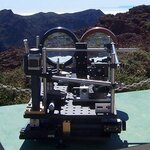Optics
The quality and size of electronic display screens may have gotten a lot better. We may also soon see erasable and rewritable electronic paper and ink that can change color electromagnetically, thanks to University of California, Riverside nanotechnologists who have succeeded in controlling the color of very small particles of iron oxide suspended in water simply by applying an external magnetic field to the solution.
In their experiments, the researchers found that by changing the strength of the magnetic field they were able to change the color of the iron oxide solution – similar to…

The ingenious system called adaptive optics, known for its computer control of subdivided, individually angled mirrors, is an efficient but expensive way to correct distortions in laser beams. The mirrors automatically adjust until an undistorted beam is obtained in a way formerly thought unachievable by a single large mirror.
Now a Sandia National Laboratories’ tool that efficiently but inexpensively uses a single mirror to achieve some of the same effects has received a U.S. patent, issued June 12.
The Sandia device, which resembles an inexpensive vise similar to those bolted to many home…
Researchers at the University of Pennsylvania have created the first three-dimensional optical images of human breast cancer in patients based on tissue fluorescence.
Fluorescence diffuse optical tomography, or FDOT, relies on the presence of fluorophore molecules in tissue that re-radiate fluorescent light after illumination by excitation light of a different color.
The reconstructed images demonstrated significant tumor contrast compared to typical endogenous optical contrast in breast. Tumor-to-normal tissue contrast based on FDOT with the fluorophore Indocyanine Green, or ICG, was two-…

Quantum entanglement is one of the many non-intuitive features of quantum mechanics. If two photons of light are allowed to properly interact with one another, they can become entangled. One can even directly create pairs of entangled photons using a non-linear process called SPDC (Spontaneous Parametric Down Conversion).
Those two entangled photons can then be separated but as soon as one of them interacts with a third particle, the other photon of the pair will change its quantum state instantaneously. This happens according to the random outcome of the interaction, even though this photon…
In the internet age, when 120,000,000 smart people on Digg can see an article about your technology, it takes some real courage to use the term "unbreakable", but the guys at NIST are doing just that.
They say they have built a prototype high-speed quantum key distribution (QKD) system that can perform a theoretically unbreakable “one-time pad” encryption, transmission and decryption of a video signal in real-time over a distance of at least 10 kilometers.
Detection stage of the NIST prototype quantum key distribution system: Photons are "up-converted" from 1310 to 710 nm by one of the two…
Researchers at the University of California, Santa Cruz, have performed atomic spectroscopy with integrated optics on a chip for the first time, guiding a beam of light through a rubidium vapor cell integrated into a semiconductor chip.
Based on the interactions of light and matter, spectroscopy is often used to identify substances by the wavelengths of light they absorb or emit. Conventional systems have many large components, whereas the compact, fully planar device developed at UCSC enables the study of atoms and molecules on a chip-based platform with integrated optics, said Holger…
Stretching a carbon nanotube composite like taffy, researchers at the National Institute of Standards and Technology (NIST) and the Rochester Institute of Technology (RIT) have made some of the first measurements* of how single-walled carbon nanotubes (SWNTs) both scatter and absorb polarized light, a key optical and electronic property.
Biomedical applications could exploit the natural fluorescence of the carbon nanotubes. When light is polarized along a single-walled carbon nanotube (left), this fluorescent emission is strong. Credit: NIST
SWNTs have excited materials scientists with the…

A new light source based on fiber-optic technology promises to improve the inspection of food, produce, paper, currency, recyclables and other products. New research revealing this technology will be presented at the Optical Fiber Communication Conference and Exposition/National Fiber Optic Engineers Conference (OFC/NFOEC), being held March 25-29 in Anaheim, Calif.
Currently, industrial processes for inspecting foodstuffs and other items often use "line-scan" cameras, which record images of objects one line at a time, just as fax machines scan documents on a line-by-line basis. Rapid…
A team of researchers from Rensselaer Polytechnic Institute has created the world’s first material that reflects virtually no light. Reporting in the March issue of Nature Photonics, they describe an optical coating made from the material that enables vastly improved control over the basic properties of light. The research could open the door to much brighter LEDs, more efficient solar cells, and a new class of "smart" light sources that adjust to specific environments, among many other potential applications.
Most surfaces reflect some light — from a puddle of water all the way to a mirror.…

New information about a link between the growth of blood vessels critical to the spread of cancer and the copper in our bodies has been discovered by researchers from the U.S. Department of Energy's Argonne National Laboratory and the University of Chicago, using a beamline at the Advanced Photon Source.
Growing new blood vessels from existing ones — a process called angiogenesis — is important in growth, development and wound healing. But it also enables the spread of tumors throughout the body, so researchers have been scrambling for ways to stop angiogenesis in the fight against cancer.…